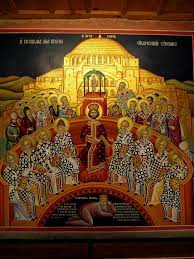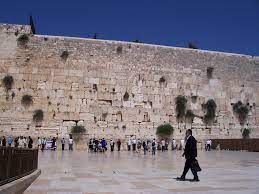Here is a tale that you can only appreciate if you are old enough to remember the days when cars had a bench front seat. It goes like this: a middle-aged couple are out for a drive when they notice two love-birds in the car ahead snuggled cheek to cheek in the front seat. “Do you remember when we used to sit like that?” the wife asks. “Yes,” the husband replies; “who moved?”
“Who moved?” That’s the question many of us are asking concerning Anglicanism. Who moved when the 1920 Lambeth Conference said marriage of one man and one woman is God’s “unchangeable standard” and the Episcopal Church replied: “It’s unchangeable until we change it.” Who moved when the 1998 Lambeth Conference stated that homosexual practice is “incompatible with Scripture” and Canterbury now says, “that was then, this is now”?
What’s ironic about the above scenario is that the Episcopal Church and Canterbury claim to own the Anglican™ brand as it were by divine right and wish to portray Gafcon as “troublers of Israel” (check out 1 Kings 18:17). The goal of this essay is to show that it is the Westernized churches and self-styled “apostolic pioneers” and “reasonable radicals” like John Spong and Martyn Percy, who have abandoned the Anglican way and that Gafcon is calling the church to turn back to its original foundations (ad fontes).
The Gafcon movement, so I contend, is carrying the banner of prophetic traditionalism.*
The 2008 Jerusalem Statement and Declaration breathes the spirit of the Prophets when it claims that “GAFCON is not just a moment in time, but a movement in the Spirit.” The churches, bishops, and people who gathered in Jerusalem were not meeting for a one-time spiritual high but for an enduring project and mission. The choice to hold GAFCON in Jerusalem, both in 2008 and again in 2018, is significant. The Prophets were profoundly conservative, calling Israel back to the “ancient paths” (Jeremiah 6:16) even as they pronounced judgment on the Jerusalem of their day and saw visions of a Jerusalem that is above (Isaiah 5:1-5; Galatians 4:26).
The same backward- and forward-looking approach recurs throughout the Statement. Following an indictment of the Anglican Establishment for allowing a false and divisive gospel to enter the church unchecked, it goes on to claim:
Our fellowship is not breaking away from the Anglican Communion. We, together with many other faithful Anglicans throughout the world, believe the doctrinal foundation of Anglicanism, which defines our core identity as Anglicans.
That foundation is stated in Canon A5 of the Church of England, which itself goes back five centuries:
The doctrine of the Church is grounded in the Holy Scriptures and in such teachings of the ancient Fathers and Councils of the Church as are agreeable to the said Scriptures. In particular, such doctrine is to be found in the Thirty-nine Articles of Religion, the Book of Common Prayer and the Ordinal.
The Jerusalem Declaration spells out this foundational commitment in more detail (for a fuller exposition of this confession, see Chapter 7 of my book).
Clause 2 defines Scripture in the words of Article XX (“God’s Word written”), and its allusion to the “plain and canonical sense” recalls Cranmer’s famous Collect which urges us to “hear, read, mark, learn, and inwardly digest” the words of the Bible and to do so with respect for the wider consensus of earlier interpreters.
In Clause 3, the Conference “upholds the four Ecumenical Councils and the three historic Creeds as expressing the rule of faith of the one holy catholic and apostolic Church.” While Anglicans may test every Creed and Council according to Scripture (Article XIX), they have generally approved Bishop Lancelot Andrewes’ dictum:
One Canon reduced to writing by God Himself, two Testaments, three Creeds, four Councils, five centuries, and the succession of the Fathers in that period – the three centuries, that is, before Constantine, and two after, determine the boundary of our faith.
Clause 4 affirms the Thirty-Nine Articles of Religion “as containing the true doctrine of the Church agreeing with God’s Word and as authoritative for Anglicans today.” In doing this Gafcon has returned to a standard which has been loosened in many Anglican churches.
Clause 6 “upholds the 1662 Book of Common Prayer as a true and authoritative standard of worship and prayer, to be translated and locally adapted for each culture.” Cranmer’s Prayer Book was itself a vernacular liturgy, which has achieved “classic” status in Anglican churches even where translated into a local tongue.
Clause 7 affirms, as does the Lambeth Quadrilateral, the historic succession of bishops, priests and deacons and the teaching of the Ordinal concerning the calling and duties of the clergy. The Jerusalem and Nairobi conferences were living convocations of all these various orders of ministry.
In a sense, the first half of the Jerusalem Declaration looks backward to the ancient paths, while the second half addresses issues of the present and future. However, even here the Declaration is drawing from tradition.
Clause 8 refers back to the 1920 Lambeth Resolutions 66-67 defining the “unchangeable standard of Christian marriage between one man and one woman as the proper place for sexual intimacy and the basis of the family,” which itself is derived from the teaching of Jesus (Matthew 19:1-6) and the Creation account in Genesis 1-2.
Clause 9 takes us to the Great Commission of the Risen Lord to make disciples of all nations (Matthew 28:18-20), which is itself rooted in God’s call to Israel to be a “light to the nations” (Isaiah 42:6). It is this missionary call which led Anglicans sacrificially to bring the Gospel to the far reaches of the British Empire.
Clauses 11-13 seek to express the delicate balance of ecumenical hope, legitimate variation on non-essential matters, and the need to reject false teaching. Some on the theological Left – these are the folk who defrocked and sued confessing Anglicans in North America – claim that Anglicanism has always been infinitely flexible in tolerating “diversity.” Not if we go back to the founders, who said this: whosoever shall be sent to teach the people, shall not only in their preaching, but also by subscription confirm the authority, and truth of those articles. He that doth otherwise, or troubleth the people with contrary doctrine, shall be excommunicated.”
The final clause of the Jerusalem Declaration sets the entire Statement in the perspective of the Second Coming of Christ. In the prophetic vision of John the Divine (the Book of Revelation), Jesus Christ, the Lamb that was slain, is revealed as the Alpha and Omega who unites the past, present, and future of the creation and history, and who will come again in glory to judge the living and the dead.
What then should we do? The Prophets of the Old and New Testaments are unanimous in replying: Repent! To the Anglican Church in particular, the Spirit says: “Remember therefore from where you have fallen; repent, and do the works you did at first. If not, I will come to you and remove your lampstand from its place, unless you repent” (Revelation 2:5).
The Anglican Reformers understood the prophetic judgment as speaking to the church of their day. The “judicious” Richard Hooker replied this way to those who accused the Church of England of having departed from the true church:
To others, by whom we are accused for schism and heresy, we have often made our reasonable and in the sight of God, I trust, allowable answers. For in the way which they call heresy, “we worship the God of our fathers, believing all things which are written in the Law and the Prophets” (Acts 24:14).
So for us today, who moved? The Anglican Establishment is installing bucket seats of “good disagreement” for the Communion. Don’t let them strap you in. Rather, move back close to the church’s Bridegroom who alone holds the keys to the future.
*Note: the logo of the “Contending Anglican” blog is taken from a print by our dear friend Molly Henning. She originally made it for the cover of a book on Jonah written by her husband, the Rev. Mike Henning, who died prematurely (for us) in 1994. I tend to see Jonah as a type of Israel closing its ears to the word of God yet compelled by His mercy to become a light to the nations. A chastened Jonah stands at the crossroad of Nineveh and whispers “Repent!” – and the whole city, even the cattle, rush to put on sackcloth and turn to the Lord! (Jonah, chapter 3).
See conversation about this article on our Facebook page.





